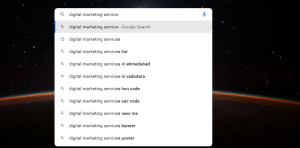Negative Keywords: An Ultimate Guide

The digital marketing plan is important for the success of businesses today. In that, paid advertising is a crucial aspect that offers a solution to increase brand awareness and also ROI. Google Ads is the most effective paid advertising platform, which allows businesses to bid on relevant keywords so their ads will show on the search engine results pages (SERPs).
Aside from bidding on the right keywords, businesses should also consider adding negative keywords to their Google Ads campaign. There are keywords you don’t want to show up for. Negative keywords help you to filter out these keywords, so your ads will only be triggered by the keywords that are relevant to your business.
For example, you have an SEO company in Austin. You are bidding on the keyword “SEO company.” However, you don’t want your ads to show up when someone searches for an “SEO course” because you don’t offer that. In this case, “course” is your negative keyword. So what are they, how to identify, and how can you use them in your Google Ads campaign?
What are Negative Keywords?
Negative keywords stop your ad from being triggered by certain words or phrases. They help you filter out irrelevant searches, so your ads will only be shown to people searching for what you offer.
The key to success for an SEO campaign is to find the right balance of positive and negative keywords. In Google Ads, target the right people with the right keywords. That means you need to bid on relevant keywords and, at the same time, use negative keywords to filter out irrelevant searches. It will maximize your chances of CTR (click-through rate) and conversion while minimizing your cost per click (CPC).
For example, let’s say you sell women’s shoes. You want to bid on the keyword “women’s shoes.” But you don’t want your ad to show up when someone searches for “men’s shoes” or “kids shoes.” In this case, “men’s” and “kids” are your negative keywords.
Benefits of using negative keywords
There are several benefits of using negative keywords in your Google Ads campaign, including:
Save money
The most obvious benefit of using negative keywords is that it saves you money. By filtering out irrelevant searches, you won’t waste your budget on clicks that will never convert.
Improve CTR and conversion
Another benefit of using negative keywords is that it helps to improve your CTR and conversion. When your ads are relevant to what people search for, they are more likely to click on your ad. And when they click on your ad, there is a higher chance they will convert.
Target the right people
Using negative keywords also allows you to target the right people with your ads. When your ads are relevant to what people are searching for, they are more likely to be fascinated by what you offer.
How to Identify Negative Keywords?
There are several ways to identify negative keywords, from the process of keyword research and manual google search to analyzing your search term report.
Find Negative Keywords During Initial Keyword Research Stages
Manage keyword research to come up with a list of relevant keywords for your business. Keep in mind your target audience and their requirements. Try to think by putting yourself in their shoes and think about what they would search for.
After coming up with a list of relevant keywords, simultaneously pick out the negative keywords that you don’t want your ad to appear. For example, if you are a digital marketing agency that provides SEO services, your relevant keywords may be “SEO agency,” “digital marketing agency,” and “online marketing agency.” But you don’t want to show up when someone searches for irrelevant keywords such as “marketing course,” “SEO tutorial,” or “digital marketing book.”
Manual Google Search

Another way to identify negative keywords is to do a manual Google search. Type in your relevant keywords and see what kind of searches come up. If you see any irrelevant searches, dodge them by adding them to your negative keyword list.
For example, searching digital marketing services may bring up results like this. You are looking for a list of digital marketing services, but the results show a “digital marketing services hsn code.” This is an irrelevant result, and you don’t want your ad to show up for this kind of search. So “hsn code” would be a great addition to your negative keywords list.
Search Term Report
Search Term Report is a gold mine for finding negative keywords. It shows the exact keyword that people have used to trigger your ad. Google Ads helps you show keywords that don’t have the right search intent.
Put your search term report in your Google Ads account, choose a date range, and filter for keywords with strong impressions but low CTR. These are the keywords you don’t want your ad to appear.
Review it regularly to ensure you are not wasting your time and money on irrelevant keywords. It is difficult to manage and clean up if you leave it for a long time.
Add Negative Keywords to Improve your Google Ads Account
After you have identified the negative keywords, it is time to add them to your Google Ads account. You can add them to two places: ad group and campaign levels.
Campaign level means that the negative keywords will be applied to all ad groups in that campaign. Ad group level means that the negative keywords will only be used for that particular ad group.
Austin SEO company professionals suggest that you should add them to both the ad group level and campaign level. This will help you to be more specific with your targeting.
When adding negative keywords, you have the option to choose between broad match, phrase match, and exact match.
Broad Match
Broad matches prevent your ad from showing up for any searches that include your keyword, even if it is in a different order or with other words in between.
For example, add “online marketing” as a negative keyword in a broad match. Your ad will not appear when people search for “online marketing services,” “digital marketing,” or “internet marketing.” Be careful with broad matches because they can block a lot of potential traffic. Make sure when you assign these keywords, all their variants are included.
Phrase Match
A phrase match is the safest option. It will block your ad from showing up when people use your keyword in the same order.
For example, if you add “online marketing” as a negative keyword in a phrase match, your ad will not show up when users search for “online marketing services,” but it will still show up when they search for “internet marketing.”
It limits the risk of hiding your ads from potential customers while still giving you a lot of flexibility.
Exact Match
An exact match is the most restrictive option. It will only prevent your ad from showing up when people search for your keyword in the same order and without any other words.
For example, add “online marketing” as a negative keyword in an exact match. Your ad will not show up when people search for “online marketing services” or “internet marketing,” but it will still show up when they search; for “digital marketing.”
This option is only recommended if you are getting a lot of irrelevant traffic from a particular keyword and you want to block it completely.
In Conclusion
Negative keywords are a powerful tool that can help you improve your Google Ads performance by blocking irrelevant traffic. Use the strategies mentioned in this blog to find the right negative keywords for your campaign. And don’t forget to review your Search Term Report on a regular basis to ensure you are not wasting your precious time and money on irrelevant keywords.
Contact an Austin SEO company if you want help with your Google Ads account. They will be able to help you optimize your account and improve your performance.




